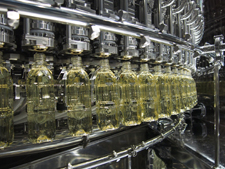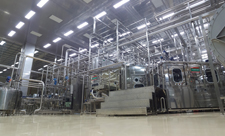DNP Develops Control Software to Reduce Sterilization Time for Aseptic Filling System by 50%
Will significantly cut product switching time and enable improved productivity and reduced environmental impact
Dai Nippon Printing Co., Ltd. (DNP) has developed a control software designed to reduce by half the time taken for sterilization treatment of equipment conducted in the preprocessing of filling operations when switching products in an aseptic filling system1 for beverages filled in Polyethylene Terephthalate (PET) based plastic bottle.
Reducing the sterilization time for filling equipment, will not only improve the production efficiency for PET plastic bottle beverages, but will also reduce environmental burdens by cutting CO2 emissions.
[Background]
Recently, increased demand has been evidenced for high-mix low-volume production in the beverage market, amidst the diversification of consumer tastes. As a result, an increase has been seen in the number of product items produced using a single aseptic filling system. This has accelerated the frequency2 of product switching, leading to higher demands to reduce the washing to sterilization time of liquid processing and filling equipment in preprocessing operations.
In answer to such demands, DNP has successfully developed a control software designed to reduce by half the sterilization treatment time for aseptic filling systems.


[At left] Beverages being filled into PET plastic bottles / [At right] Overview of aseptic filling system
[Before and After Comparison Using New Software]
Before:
When sterilizing aseptic filling equipment to date, the beverage tank and pipes have been heated with steam or boiling water, and sterilization carried out for 30 minutes at a constant temperature after reaching 130C, as measured on thermometers installed at between 10 to 20 locations inside the liquid processing and filling equipment. As a result, from commencing sterilization, approximately one hour was originally required for the equipment to return to room temperature following sterilization, and filling could commence.
After:
- Utilizing the cutting edge technology and know-how built up through more than 45 years of developing, and marketing aseptic filling systems, DNP has successfully developed a control software with default conditions capable of attaining the same sterilization effect as before, while halving the sterilization time at maximum. By introducing this software, sterilization time can be reduced from the previous one hour to approximately 30 minutes, achieving significant productivity improvements. For example, at a factory conducting 300 product switch outs per year, it will now be possible to reduce the required time by approximately 150 hours. As a result of reducing such processing time, heat energy and CO2 emissions in the sterilization process are also reduced, leading to a lower environmental burden.
- The newly developed software is compatible with all aseptic filling systems such as plastic-bottled drinks and those for paper containers, pouch packaging and single-serving packs. DNP will market the software to companies using aseptic filling systems.
- The Company holds seven domestic and two overseas (one in the USA and another in China) patents, for the software and related technologies.

Comparison of sterilization time on a before and after basis using the newly developed software.
[Looking Ahead]
DNP will market the control software to companies with aseptic filling systems, such as food and beverage makers, and those looking to introduce such facilities, aiming for annual sales of 2.0 billion yen by FY 2022.
1: The aseptic filling system for PET plastic bottles provided by DNP, fills the sterilized beverage at room temperature under sterile factory conditions. As long-term sterilization at high temperature is unnecessary, and manufacturing at room temperature possible, there is no need to increase the heat resistance of the material, and resource saving can be achieved by thinning and lightening the materials. In a domestic first, in 1997, the Company introduced an In-line Molding Method allowing for the delivery to beverage factories of PET preforms, test tube-like format, where the beverage has been aseptically infused at the same time as the preform is inflated. By supplying mini preforms to the factory, transportation costs can be drastically reduced. As of September 2017, approximately one-third of all plastic bottled beverages currently sold in Japan are manufactured with the DNP aseptic filling system.
2: While the number of product-switch outs per aseptic filling system varies from manufacturer to manufacturer, 2016 saw an increase to approximately 300 to 500 times from about 100 to 300 times per year previously.
* Product prices, specification and service contents mentioned in this news release are current as of the date of publication. They may be changed at any time without notice.
- Select location
-
- Category
-